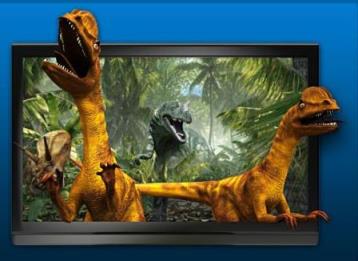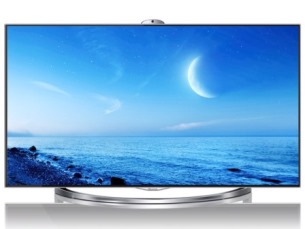Back in June, Bloomberg BusinessWeek wrote an article about ESPN calling it quits with 3D-TV, which they said meant that "Nails are being banged into the coffin for 3D television."
They're wrong.
In fact, very wrong. The problem is that Bloomberg was confusing 3D-TV with glasses and glassless 3D-TV. Two very different kettle of fish. I do suspect that stereoscopic 3D-TV (with glasses) is heading towards its end -- as it should. More on that latter, but it was a bad idea, and it remains a bad idea.
The larger issue is the analysis misses -- for lack of a better term -- the iPhone/iPad model. There had been cell phones, and there had been portable computers. But if you come up with something that not only simplifies how those work, and -- more importantly -- work in a way that people do, then you're on to something. And something potentially big.
That's why glassless 3D-TV is another matter entirely. And a tiny company you've never heard of (unless you read this column...), Stream TV Networks, has just changed the landscape with some major announcements. And a new product.
Last year at a 3D Symposium in Los Angeles, there was panel discussion about the future of 3D-TV. All the panelists but one were involved with 3D-TV with glasses. Only Mathu Rajan, president of Stream TV Networks, was there on behalf of glassless-3D. And when one of the other panelists dismissed glassless as being "at least five years away," Mr. Rajan sat silently, not saying that they were actually going into production in just a few months.
And that future is here now. As in -- TV sets using their Ultra-D technology are in production, rolling off the lines -- now -- and three weeks ago I was given a private demonstration with one of the production units. And in a word, it was spectacular. But here's the far-more important thing: what was impressive goes far beyond that it can do 3D-TV without glasses. That's because it remarkably solves the far-more important problem of "no content." It also is simply stunning resolution, whether or not you even ever use 3D. But ...most critically...it operates the way you do. It lets you watch TV the way you have always watch TV.
More on all that in a moment, but a bit of background is in order first.
Back in 2011 at the Consumer Electronics Show, I accidentally stumbled on this tiny company, Stream TV Networks. They were hidden away in the wrong hall, far away from all the other television companies over in the Central Hall. They were mainly displaying tablets. But in a closed-off office, they were demonstrating a very early beta version of their glassless 3D-TV. And even then, it amazed me. 3D-TV without glasses, go figure, and yet this tiny, hidden company blew away all the big conglomerates who were trying to push 3D-TV with glasses. I wrote glowingly about them at the time (under its tablet division, eLocity) saying, "its 3D television impressively has almost none of these sight lines, which makes it one of my favorite 'cool' products."
The next year, they finally made to into the same hall with all the other TV people. But while the Big Boys only had tiny experimental displays for glassless 3D-TV, where you had to literally stand in one, exact spot to watch a two-minute video of animated fish -- Stream TV Networks (are you ready?) had converted Harry Potter, and you could wander around the room and watch the entire feature film in 3D (without glasses!) from anywhere. And the quality was good.
3D-TV has gotten blasted recently for not delivering on its promise, but as noted the problem isn't 3D television, but because 3D-TV with glasses is a bad concept. It's based on a premise contrary to how people actually watch television. People watch TV while reading books, talking on the phone, texting, eating, chatting with others in the room and wandering to the kitchen and bathroom. Right? Doing all that while wearing 3D glasses simply doesn't work. And then factor in that you need to have enough glasses handy for your entire family...and for all the guests who might come to your house to visit -- and what if have, God forbid, a Super Bowl party>. Moreover, without glasses, the TV was useless, because everything would be blurry. But worst of all -- easily worst of all -- add in that there was almost no 3D content.
But 3D-TV without glasses? Ah, now the story is different. Not needing 3D glasses, after all, you can watch TV and live your life exactly as you always do. Wander anywhere, read books, have a roomful of guests. And Stream TV Network's Ultra-D technology ratcheted the bar up even higher -- because it eliminated two other major problems:
First, Ultra-D lets you adjust the level of "pop." You can simply turn a dial and have huge 3D pop, though a slightly-less crisp picture. Or you could have full, great clarity, just with a bit less pop. Or...(and this is the important point), you could turn it off entirely, and simply watch TV, like always! If you don't want to watch the news in 3D, you don't have to. And there's no worry about any blurry image for people who don't have glasses..
But far better, and most important and remarkable (and yes, I know I'm using a lot of superlatives here, but this is a game-changing technology), Ultra-D got rid of the major problem of there being "no content." That's because -- Ultra-D lets you convert any normal television content... in real-time. That means you can watch a regular football game or any movie or sitcom or cartoon -- and have it converted to glassless 3D as you watch! Well, so long to the "no 3D-TV content" problem. The problem doesn't exist. Everything can be immediate 3D content.
Everything.
And keep in mind, all this was two years ago. It only gets more fascinating.
While all the major companies were still focused on 3D-TV with glasses, Stream TV Networks had skipped past that and developed their Ultra-D technology. That's what put them light-years ahead of everyone, including the major companies.
I've seen the Ultra-D technology develop and what was good before had become impressive. You stand looking at a 2D television knowing that it's impossible to see a 3D image without glasses -- yet there it is. And the once fuzzy-ish image had now become crisp and clear.
But even that has now changed and leaped far ahead. Which brings us to the private demo two weeks ago with a production unit ready for the market.

It's thanks to two things. 1) Partnerships with major manufacturers, most notably Hisense (a leading company in China) and Pegatron, which builds the iPhone. But there are also partnerships with six other TV companies they told me about off-the-record -- and one Really Big TV company. "Really big" as in huge. And 2) the advance of 4K technology.
This part about 4K might seem a little techie at first, but I'll make it understandable. And it's critical, central to all this big news.
You've likely heard of HD and 1080p resolution. That's the high-end standard today. (The 1080p stands for the number of vertical pixels, which is what creates a sharp resolution.)
What 4K does (also referred to as 2160p) is quadruple the resolution. If you think HD is a great picture, imagine it four times better -- crisper, sharper, far more minute detail. Stunning clarity that's hard to imagine in a TV, let alone describe. The biggest problem with 4K today, though, aside from price, is -- once again, there's no content. Having a 4K television isn't like merely getting a better monitor. Think of it this way: let's say that 30 years ago you just bought the world's great Blu-Ray player -- but they haven't invented even DVDs yet. They only have VHS tapes. It doesn't matter how great your Blu-Ray player is, if there's nothing to play on it. That's the problem with 4K: it's a different technology. There's no native content.
(It is a far bigger problem than most people realize. And that's the problem often with new technology. It's rushed out for it's ready, and so there's no content. Consider: a movie in native 4K content requires so much "digital information" in its pixels it could be up to 250 GB. A normal HD movie is only 8 GB. That's like needing 30 DVDs for one movie! Imagine how long it would take to stream a single movie. Imagine how the pipeline would be clogged. It's borderline unworkable.)
But that's where the Ultra-D technology comes in again. Because Stream TV Networks has advanced Ultra-D to do the same thing with 4K that it did with standard 3D-TV. It can convert over-the-air, regular telecasts to be 4K-3D TV compatible... in real time. You can watch it all in 4K-3D, and as it's happening. The same with any movies you rent. There is no problem with content. None. Everything is content.
Everything.
And when I say, "everything," I don't just mean TV shows or movies you rent. But movies you stream from Netflix. And whatever you watch on Hulu or YouTube. Or any game you play on an Xbox, or PS3, or anything streamed from your computer to the TV.
Everything. As in... everything. It all can be converted to 4K-3D -- in real time.
And how is the quality?
As I said, three weeks ago, I was shown a demo of the 50-inch 4K-3D TV -- a model off the production line. It was showing the movie, Avatar. And the resolution was spectacular. As vibrant and crisp as it would seem an image could be. Even when I adjusted the 3D pop to about 75 percent, the TV image was still very clear. Down at 40 percent, the resolution was breathtaking, and yet there still was a sense of depth. I wandered around the room, and there was no discernible fuzziness. (At the very highest end, nearing 90-100 percent there might be.)
Avatar was already a 3D movie to begin with, so they put in a regular 2D movie, and converted it in real-time to 4K-3D as we watched. There wasn't nearly the same pop as a movie made for 3D (nor did I expect it), but there still was a rich sense of depth. And most importantly, this demo wasn't just about 3D, but the 4K resolution. Watching anything in 4K is otherworldly amazing.
Yes, again, I know the whole "hyperbole" thing. But imagine if you were used to watching black-and-white television and then someone showed you a color TV. 4K-3D isn't "better" television, it's basically a new technology. Yet it takes that aforementioned iPhone/iPad model and lets you watch TV simply and as you always do. With an overflowing library of content.

(This is a Hisense model with Ultra-D. And yes, I know you can't see a 3D image...)
Once upon a time, 3D-TV with glasses had a much better "pop" than glassless, even though it wasn't a particularly useful technology. But that gap is now closed. Because with 4K resolution, the issue is no longer just 3D, but pure resolution. And most important of all, glassless 3D-TV is actually usable.
"This is a different technology that can create a totally different viewing experience," Mathu Rajan, president of Stream TV Networks, says. "It's the beginning of the hologram because you can almost see around it."
But that's only part of the story, because Stream TV Networks is building on the Ultra-D technology, which is a large part of what they're rolling out and announcing.
One thing, for example, is that they have a deal with Qualcomm to produce a new chip expressly for them based on the high-end Snapdragon S4 prime quad core. That's a bit techie -- but what this means for humans is that all the Ultra-D technology can now be put on a little chip, rather than needing a set-top box. That not only simplifies things for the user, but it lowers the cost dramatically.
(They will have two lines of TV sets, one which uses a set-top box, since that will allow for additional feature that videophiles might want.)
This all will let the pricing be "shockingly low," as Mr. Rajan puts it. He notes that Sony right now is selling a huge 65" 2D-4K set in Australia for $11,000. But one of his partners, Hisense, is selling a similar model for less than half that. Yet when Hisense's model with Ultra-D is released soon, the price will drop even more. And keep in mind: Ultra-D allows for 3D, not mere 2D. Moreover, they'll be selling more standard 50" models, which will lower the price further.
And rather than the "five years" that ill-informed 3-D panelist guessed last year, production has already begun. Demo units will be available in stores very soon. "Well before the end of year," Rajan says.
Yet the company is now slowly-announcing that this goes further than simply 3D TV.
Stream TV Networks is actively developing tablets and smartphones -- right now -- that will have the Ultra-D technology in them, thanks to that Qualcomm Snapdragon chip. Glassless 3D will therefore be available for any content you can view on those devices (most notably games, I would imagine).
Talking with the ebullient Mathu Rajan is like being on the receiving end of a non-stop game of dodgeball. He is wildly enthusiastic and loves talking about his company's product, most notably because so many in the industry have long been skeptical of what he has been insisting his company is doing. While these non-believers have been incredulously wondering where the product is, Rajan says that Stream TV Networks chose to get everything right first and even put things off for a year when they saw that 4K was nearing, so that the public would have a full, proper experience. And so they could develop an algorithm that transcended the native 4K content problem. Where, like the iPhone and iPad, it could be used simply by anyone and used immediately, rather than just be a "cool technology" that wasn't practical -- like 3D-TV with glasses. And have content.
And now, glassless 3D-TV is here. It's not a rumor. I've watched an actual production model. And with the 4K resolution, it does appear to take technology to a different level.
"There is a triple benefit of Ultra-D," Mathu Rajan bubbles. "You get the benefit of 3D and there's the amazing 4K resolution, but also with real-time converting, you have all content available to you - not to mention it can play native 4K content, of course."
With any new technology, there's always a question of the public adopting it. That remains a question with glassless 3D-TV and with 4K resolution. But having seen the quality of resolution, even if you never use 3D -- and seeing the quality of the 3D for those who want it. And seeing how all content is available to it. And seeing the ease of using it, virtually the same as using any standard TV today. And knowing where the price is going to be -- and what other products are being developed with Ultra-D, and the partnerships already in place, Stream TV Networks has certainly at least positioned itself to move forward.
I know, too, that all this sounds hugely spirited. And that therefore there is always going to be skepticism. But this isn't a case of being handed an overly-enthusiastic PR scoop -- I've been following this company and reporting on them for 2-1/2 years. More to the point: imagine if you saw color TV for the first time in black-and-white world. Or an iPad for the first time. Some things do deliver on their promise. Where it all goes with the public -- who knows? But I've followed this company for almost three years from it being in a closed-off back room to now, with glassless 4K-3D. And it delivers.
At the very least, it's remarkable.
*
Robert J. Elisberg's new novel The Wild Roses, a comic adventure in the spirit of The Three Musketeers but with three women, is now available here in paperback or for $3.99 as a Kindle eBook. His other political and tech writing can be found at Elisberg Industries.
